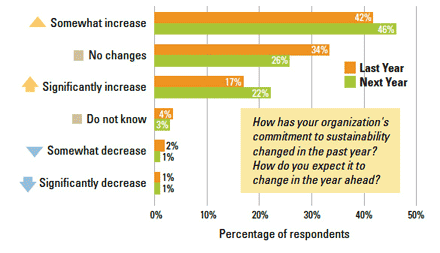Sustainability-Driven Spending Steadily Rising
Despite the effects of the financial crisis, a slow economy in much of the world and continuing inaction by political bodies, the level of business investment in sustainability activities has been steadily rising.
Respondents to the second annual Sustainability & Innovation Global Executive Study — a collaboration between MIT Sloan Management Review and the Boston Consulting Group — also say they expect their spending to grow further in the coming year.
The Question: How has your organization’s commitment to sustainability changed in the past year?
More than half of respondents reported that they had either “increased” or “significantly increased” management attention and investment, and the trend is speeding up. The largest change projected for the coming year is in the category of organizations planning to “significantly increase” investments — which jumps by almost a third.
Are these strategic intentions a reflection of deepening commitment to sustainability, or are they a broader sign that business spending in general is accelerating out of the downturn?
Results of other questions in the survey seem to confirm a growing sense that sustainability demands strategic attention. However, for most survey respondents this view is no more than a leap of faith. Only about one in three executives are able to say with any conviction that sustainability adds to profitability today.
That stat wouldn’t surprise Peter Graf, the chief sustainability officer of business management software company SAP. He says that making the business case for sustainability investments involved careful strategy: sending lots of very short e-mails about the topic and terminology, scheduling individual two-hour meetings with board members focused to their interests.
“When the board met as a group, it was, arguably, the best-prepared board meeting I’ve ever been at,” Graf told MIT SMR in an interview last fall. “It was a complete home run. One person said, ‘We’re having the conversation here that I have with my kids at every dinner.’ I was surprised how strong their commitment was and how immediate their agreement was that we have to adopt a long-term strategic focus on sustainability.”
As investments do increase, executives would do well to remember that many people “often stumble in making the transition because of basic misconceptions about what it will take to transform their companies.�


Comment (1)
Sustainability Spending Steadily Rising | Live Green